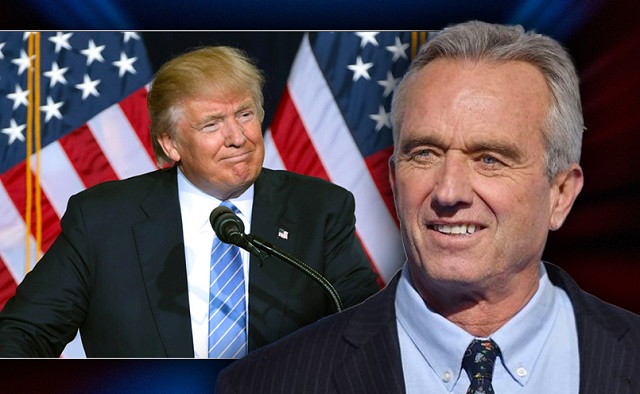International
RFK Jr’s powerful speech to America explaining his dramatic political journey

From LifeSiteNews
RFK Jr. is throwing his support behind Donald Trump over agreement on ‘existential issues,’ including free speech, and over his concern about the Democratic Party ‘dismantling’ democracy and rejecting its previous ideals.
Democratic environmental activist turned independent presidential candidate Robert F. Kennedy Jr. has withdrawn from the race and endorsed the Republican nominee, former President Donald Trump, following Democrats’ replacement of incumbent President Joe Biden with Vice President Kamala Harris as their presumptive nominee.
Kennedy made the announcement in a speech live-streamed across social media, opening by recalling that he considered the Democratic Party of his youth a party of workers, free speech, transparency, and democracy, but left when it became clear to him that was no longer the case. He then thanked his team for their strenuous work to collect the signatures necessary to get on the ballot.
“I will leverage your tremendous accomplishments” to advance his and his supporters’ shared values, he went on, claiming he believed he would have won the election in a fair system and independent media, and without social media censorship.
But “in the name of saving democracy, the Democratic Party set itself to dismantling it,” he said, describing the Democratic National Committee’s legal challenges to his own bid, “rigging” of the Democratic primary on behalf of Biden, and eventual replacement of him with Harris, as well as the government’s various prosecutions of Trump.
At the same time, he took solace in his ideas “flourishing” over the past year, particularly among young people, thanks in large part to alternative media.
In keeping with his desire not to become a “spoiler” with no path to the White House himself, and considering his internal polling showing that remaining in the race would have thrown the outcome to Harris, Kennedy announced that he is suspending his campaign and endorsing Trump over the issues of “free speech, war in Ukraine, and war on our children,” including chronic disease.
Notably, he stressed that while he is having his name removed from the ballots of 10 battleground states where he could impact a close race, it will remain in solid red and solid blue states, where he gave his blessing for supporters to vote for him on the outside chance nobody else won enough support for an outright victory.
Kennedy added that over the past two months, he and Trump have had a series of productive discussions about working together on “existential” issues on which they are aligned, while continuing to disagree on issues where they differ. By contrast, he says he tried to initiate similar discussions with Harris, but was rebuked.
Video Note: RFK Jr speaks at 41:10 of this video. Skip ahead to 41:10
Robert F. Kennedy Jr. Address to the Nation https://t.co/Wf4xt12GSX
— Robert F. Kennedy Jr (@RobertKennedyJr) August 23, 2024
Kennedy, nephew of the late President John F. Kennedy and son of the late Attorney General Robert Kennedy, announced in April 2023 he would be running in the Democratic primary against Biden, presenting himself as a challenger to the platforms of both parties. But after months of accusing party leadership of having “rigged” the primary process against him, Kennedy announced that October that he was switching to an independent bid.
As a longtime Democrat, Kennedy held and continues to hold left-wing views on most issues, but enjoyed support along non-traditional lines and even among some conservatives for his strong criticism of COVID-19 lockdowns, mandates, and shots, to the point that there is some overlap between fans of Kennedy and fans of Trump, whose administration initially backed the lockdowns before changing course and who embraces the shots to this day while criticizing mandates.
Few expected Kennedy to actually become president, but he generated significant speculation as to whether he would draw more votes from Trump or Biden (who has since stepped aside in favor of nominating Harris) and was embraced as a symbolic protest vote for many dissatisfied with the major parties.
However, Kennedy blunted much of the enthusiasm for himself in March when he announced as his running mate tech industry insider Nicole Shanahan, whose background as a Democratic donor disappointed many who had expected a more outside-the-box pick.
Rumors first surfaced last month that Kennedy was planning to drop out and endorse Trump, which he called “FAKE NEWS” at the time. The same rumor returned this week, but instead of denying it Kennedy announced only that he would “address the nation live on Friday about the present historical moment and his path forward.”
Further adding credibility to the speculation was Shanahan expressing unusual candor in a Tuesday interview about the campaign contemplating whether to “stay in the race and run the risk of a Kamala Harris and [Tim] Walz presidency because we draw votes from Trump” or “walk away right now and join forces with Donald Trump.”
It remains to be seen whether Kennedy’s support will impact the trajectory of the race. National polling aggregations by RealClearPolitics and RaceToTheWH currently show a close but persisting lead for Harris in both popular vote and Electoral College projections.
International
$2.6 million raised for man who wrestled shotgun from Bondi Beach terrorist

More than $2.6 million has been raised for a suburban Sydney shop owner who put himself directly in the line of fire to stop a terrorist during last Sunday’s attack at Bondi Beach, a moment of raw courage that has resonated far beyond Australia’s shores.
The GoFundMe campaign for Ahmed al Ahmed surpassed the $2.6 million mark by Sunday morning, fueled by more than 45,000 donations after video of his actions spread rapidly online. The footage shows Ahmed charging one of the attackers, tackling him to the ground, wrenching a shotgun from his hands, and turning the weapon back on the would-be killer to prevent further carnage.
Ahmed, you are an Australian hero.
You put yourself at risk to save others, running towards danger on Bondi Beach and disarming a terrorist.
In the worst of times, we see the best of Australians. And that's exactly what we saw on Sunday night.
On behalf of every Australian, I… pic.twitter.com/mAoObU3TZD
— Anthony Albanese (@AlboMP) December 16, 2025
Ahmed, 44, is a father of two young daughters, ages five and six, and owns a small shop in suburban Sydney. His intervention came at a brutal cost. As he fought to disarm the first attacker, a second terrorist opened fire on him, shooting him multiple times in an effort to stop him from taking control of the gun. Ahmed survived, but only narrowly.

The overwhelming financial support has turned Ahmed into an unlikely national figure — not because he sought attention, but because he acted when others couldn’t. The outpouring of donations has unfolded alongside growing public anger toward Prime Minister Anthony Albanese’s government, which has faced mounting criticism over its handling of rising antisemitic violence across Australia in the wake of recent terror incidents.
For many Australians, the contrast has been impossible to miss: ordinary citizens stepping up with courage and clarity while political leaders scramble after the fact. Ahmed didn’t wait for instructions or statements. He saw a threat, moved toward it, and stopped it — and millions of people around the world have now responded in kind.
Business
Some Of The Wackiest Things Featured In Rand Paul’s New Report Alleging $1,639,135,969,608 In Gov’t Waste


From the Daily Caller News Foundation
Republican Kentucky Sen. Rand Paul released the latest edition of his annual “Festivus” report Tuesday detailing over $1 trillion in alleged wasteful spending in the U.S. government throughout 2025.
The newly released report found an estimated $1,639,135,969,608 total in government waste over the past year. Paul, a prominent fiscal hawk who serves as the chairman of the Senate Homeland Security and Governmental Affairs Committee, said in a statement that “no matter how much taxpayer money Washington burns through, politicians can’t help but demand more.”
“Fiscal responsibility may not be the most crowded road, but it’s one I’ve walked year after year — and this holiday season will be no different,” Paul continued. “So, before we get to the Feats of Strength, it’s time for my Airing of (Spending) Grievances.”
Dear Readers:
As a nonprofit, we are dependent on the generosity of our readers.
Please consider making a small donation of any amount here.
Thank you!
The 2025 “Festivus” report highlighted a spate of instances of wasteful spending from the federal government, including the Department of Health and Human Services (HHS) spent $1.5 million on an “innovative multilevel strategy” to reduce drug use in “Latinx” communities through celebrity influencer campaigns, and also dished out $1.9 million on a “hybrid mobile phone family intervention” aiming to reduce childhood obesity among Latino families living in Los Angeles County.
The report also mentions that HHS spent more than $40 million on influencers to promote getting vaccinated against COVID-19 for racial and ethnic minority groups.
The State Department doled out $244,252 to Stand for Peace in Islamabad to produce a television cartoon series that teaches children in Pakistan how to combat climate change and also spent $1.5 million to promote American films, television shows and video games abroad, according to the report.
The Department of Veterans Affairs (VA) spent more than $1,079,360 teaching teenage ferrets to binge drink alcohol this year, according to Paul’s report.
The report found that the National Science Foundation (NSF) shelled out $497,200 on a “Video Game Challenge” for kids. The NSF and other federal agencies also paid $14,643,280 to make monkeys play a video game in the style of the “Price Is Right,” the report states.
Paul’s 2024 “Festivus” report similarly featured several instances of wasteful federal government spending, such as a Las Vegas pickleball complex and a cabaret show on ice.
The Trump administration has been attempting to uproot wasteful government spending and reduce the federal workforce this year. The administration’s cuts have shrunk the federal workforce to the smallest level in more than a decade, according to recent economic data.
Festivus is a humorous holiday observed annually on Dec. 23, dating back to a popular 1997 episode of the sitcom “Seinfeld.” Observance of the holiday notably includes an “airing of grievances,” per the “Seinfeld” episode of its origin.
-

 Agriculture2 days ago
Agriculture2 days agoWhy is Canada paying for dairy ‘losses’ during a boom?
-

 Alberta2 days ago
Alberta2 days agoAlberta’s new diagnostic policy appears to meet standard for Canada Health Act compliance
-

 Bruce Dowbiggin1 day ago
Bruce Dowbiggin1 day agoHunting Poilievre Covers For Upcoming Demographic Collapse After Boomers
-

 Business1 day ago
Business1 day agoState of the Canadian Economy: Number of publicly listed companies in Canada down 32.7% since 2010
-

 Censorship Industrial Complex22 hours ago
Censorship Industrial Complex22 hours agoCanadian university censors free speech advocate who spoke out against Indigenous ‘mass grave’ hoax
-

 Alberta1 day ago
Alberta1 day agoHousing in Calgary and Edmonton remains expensive but more affordable than other cities
-

 Censorship Industrial Complex2 days ago
Censorship Industrial Complex2 days agoTop constitutional lawyer warns against Liberal bills that could turn Canada into ‘police state’
-

 Business2 days ago
Business2 days agoJudge Declares Mistrial in Landmark New York PRC Foreign-Agent Case






